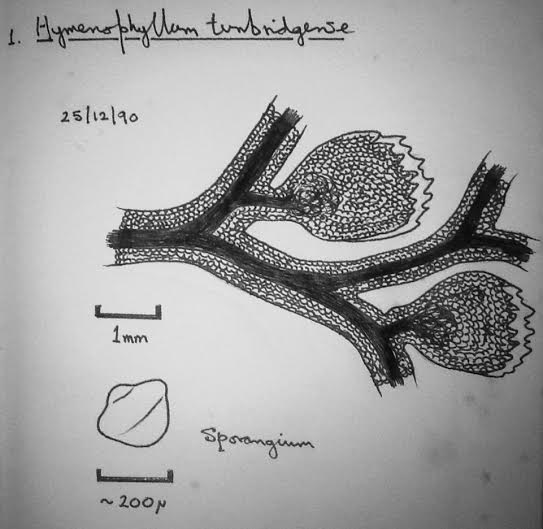Exploring Woolly Filmy Fern
Scientifically recognized as Hymenophyllum tunbridgense and classified under Family Hymenophyllaceae, stands out as a distinctive Fern known for its unique characteristics. While it may also be found under other Synonyms, Trichomanes tunbridgense.withN/A form. You can use our free plant care app PlantPlants to identify Woolly Filmy Fern.
Temperature
Min: 5 C (41 F), Max: 30 C (86 F).
Watering
Requires consistent moisture; do not let dry out.
Fertilizing
Balanced, diluted fertilizer.
Sunlight
Partial to full shade.
Toxicity
Non-toxic, but not typically consumed.



Appearance and Growth Of Woolly Filmy Fern
At maturity, this species reaches approximately 12-20 cm tall, presenting Delicate, thin, and hair-like leaves, often with a woolly texture. along with N/A (ferns do not have flowers), followed by Spores produced in capsules.. These features are supported by a reliable Fibrous roots, mostly shallow., ensuring stability and sustained growth.
Woolly Filmy Fern Origin and Habitat
Native to Native to Europe, particularly in moist, shaded woodlands., Woolly Filmy Fern thrives in Prefers high humidity and shaded areas, often found on rocks or logs. at elevations around Typically found at low to mid elevations.. Best suited for USDA Hardiness Zone Zones 6-8.. Whether grown indoor, in a curated garden or a more natural setting, its ecological requirements help maintain its vigor over time.
How to take Care of Woolly Filmy Fern
Light, Soil and Watering Woolly Filmy Fern.
You can use our free plant identify app PlantPlants to chose the best spot for Woolly Filmy Fern, This plant prefers Partial to full shade. and flourishes in Moist, well-draining soil rich in organic matter. with a soil pH of about 5.0 to 7.0..
Woolly Filmy Fern needs watering,Requires consistent moisture; do not let dry out., guided by PlantPlants app, You can get plants daily watering schedule. to maintain Prefers consistently moist conditions., ensure steady hydration. Applying water through Regular misting or watering to maintain humidity. supports even distribution and helps prevent overwatering or dryness.
Temperature and Humidity
Woolly Filmy Fern performs best within 10 C to 25 C (50 F to 77 F).. Its ideal growth occurs at around 20 C (68 F)., though it tolerates ranges from Min: 5 C (41 F), Max: 30 C (86 F).. Additionally, maintaining High humidity (60-80%). encourages healthy foliage and overall plant vigor.
Fertilization & Soil Health
Feeding with Balanced, diluted fertilizer. at the recommended Seasonal Application Frequency on PlantPlants App keeps nutrients balanced. Incorporating Compost or well-rotted leaf mulch. enhances soil structure and fertility, while staying alert to Yellowing leaves may indicate nitrogen deficiency. helps you adjust care as needed to maintain optimal plant health.
Routine and Maintenance
Regular attention ensures this plant’s beauty and longevity. Remove old fronds in early spring. for Snip away dead or damaged fronds at the base. tidies its appearance, while Every 2-3 years or when the plant outgrows its container. may be necessary as it grows, requiring a Increase pot size by 2-5 cm in diameter. increase and a fresh 2 parts peat, 1 part perlite for good drainage.. for Staking or Support. Generally does not require support unless in windy areas..
Seasonal Changes and Propagation of Woolly Filmy Fern
During Little to no dormancy, but growth may slow in extreme cold., growth may slow and some Leaf tips may brown in dry conditions. can occur. For those looking to propagate, consider Spores or division. and provide Requires consistent moisture and warm temperatures; spores take longer to germinate. when starting from seed. If using cuttings, follow European ferns can be rooted from divisions of established plants. to ensure successful rooting and healthy new plants.
Pests, Diseases and Prevention
our free plant identify and care app PlantPlants can help you diagnosisWoolly Filmy Fern problems.Though generally robust, keep watch for Aphids, slugs, and mealybugs. and remain vigilant against Root rot if overwatered.. Implementing Routine check-ups and maintaining proper moisture levels. and applying Insecticidal soap for pests and improving drainage for rot. when issues arise will help sustain the plant thriving.
Companions and Uses of Woolly Filmy Fern
This plant pairs nicely with Other ferns, shade-loving plants. and shows None known., making it a flexible choice for various Used for shade gardens, under trees, and in containers..
Edible and Cultural Aspects
the Edible Parts: N/A.. Toxicty of Woolly Filmy Fern, Non-toxic, but not typically consumed.. learning about its N/A., N/A., and N/A. can be intriguing for culinary explorers. Some traditions highlight its Historically used in some cultures to alleviate various ailments, but no strong medicinal backing. or note its Often used in traditional gardens and adds beauty with its delicate appearance..
Conservation and Status
With an Not evaluated, but is common in suitable habitats., proper Protecting native habitats from development and pollution.
Frequently Asked Questions
1. How often should I water Woolly Filmy Fern?
Water every 3-5 days in summer, ensuring the soil remains moist.
2. Can this fern tolerate direct sunlight?
No, it prefers shady conditions.
3. How do I propagate Woolly Filmy Fern?
Propagation can be done via spores or by dividing an existing plant.
4. What kind of soil does it prefer?
Moist, well-draining soil rich in organic matter.
5. Does it have any pests?
Common pests include aphids and mealybugs.
6. Is it safe for pets?
Yes, Woolly Filmy Fern is non-toxic to pets.
7. What temperature range is ideal for growth?
Ideal growth temperature is around 20 C (68 F).
8. When should I prune the fern?
Prune old fronds in early spring before new growth appears.
9. How do I ensure high humidity for the fern?
Regular misting and keeping the plant in a humidity tray can help.
10. What are the signs of nutrient deficiency?
Yellowing leaves may indicate nitrogen deficiency.




